Farm Club in San Francisco
/A brief introduction to the Farm Club Retreat in San Francisco.
Read MoreJuly, 2023: I have switched to writing most of my blog posts on my original WordPress blog so access all the current news there and sign up on that site for email updates.
A brief introduction to the Farm Club Retreat in San Francisco.
Read MoreWe live by seasons…and this one is breeding season.
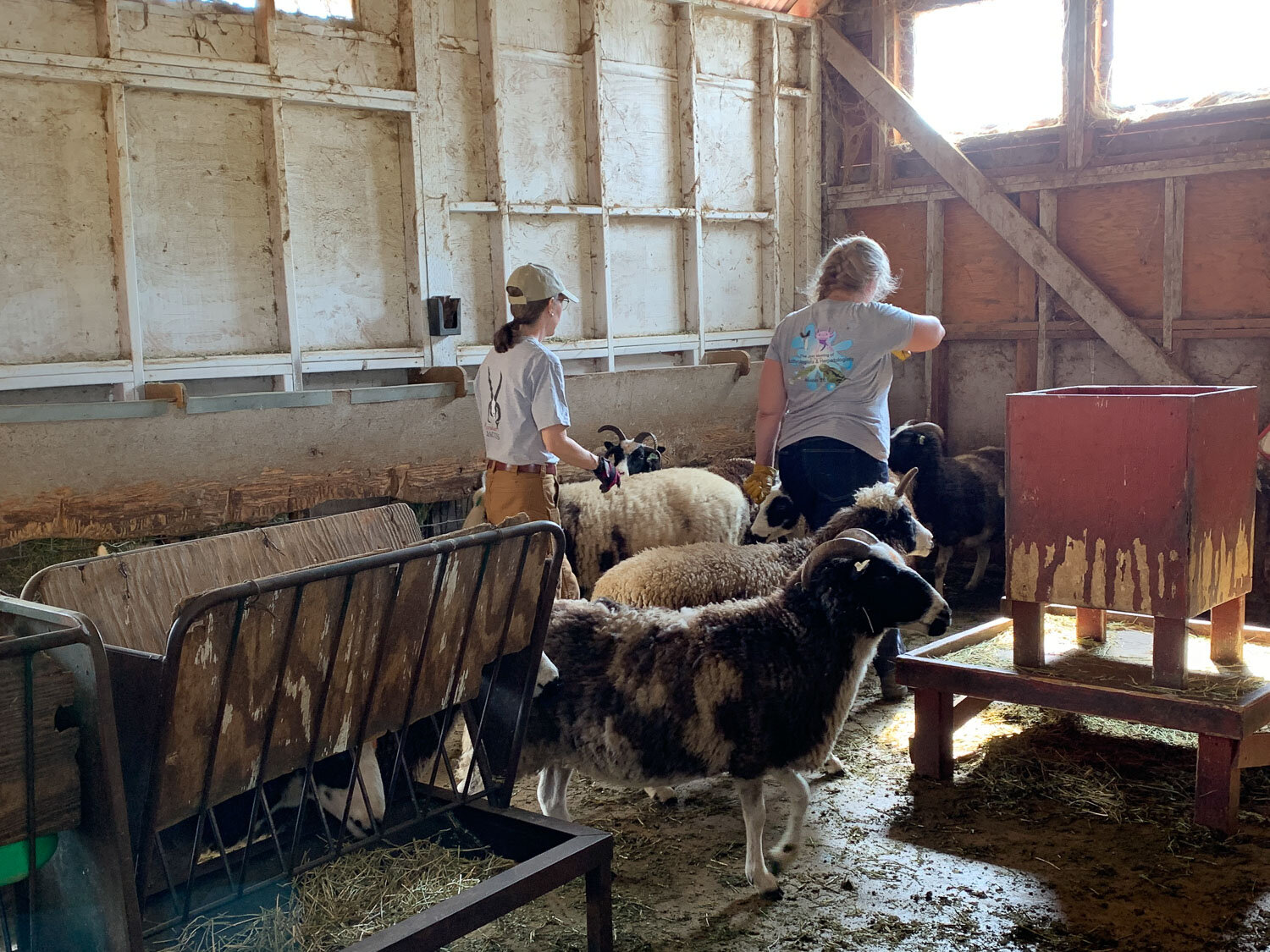
On Sunday Farm Club members came to help. We started by sorting ewes. We also replaced old smaller ear tags with some that are a little larger and more legible. We colored coded the 2018 and 2019 ear tags. I had already tagged the 2020 ewes with blue tags. I can identify many of the sheep by their markings but I don’t remember all 60+ of them. The larger ear tags make it easier to read the tag and to find a particular sheep when you can narrow down the year by the ear tag color.

Then we put the markers in the ram harnesses.
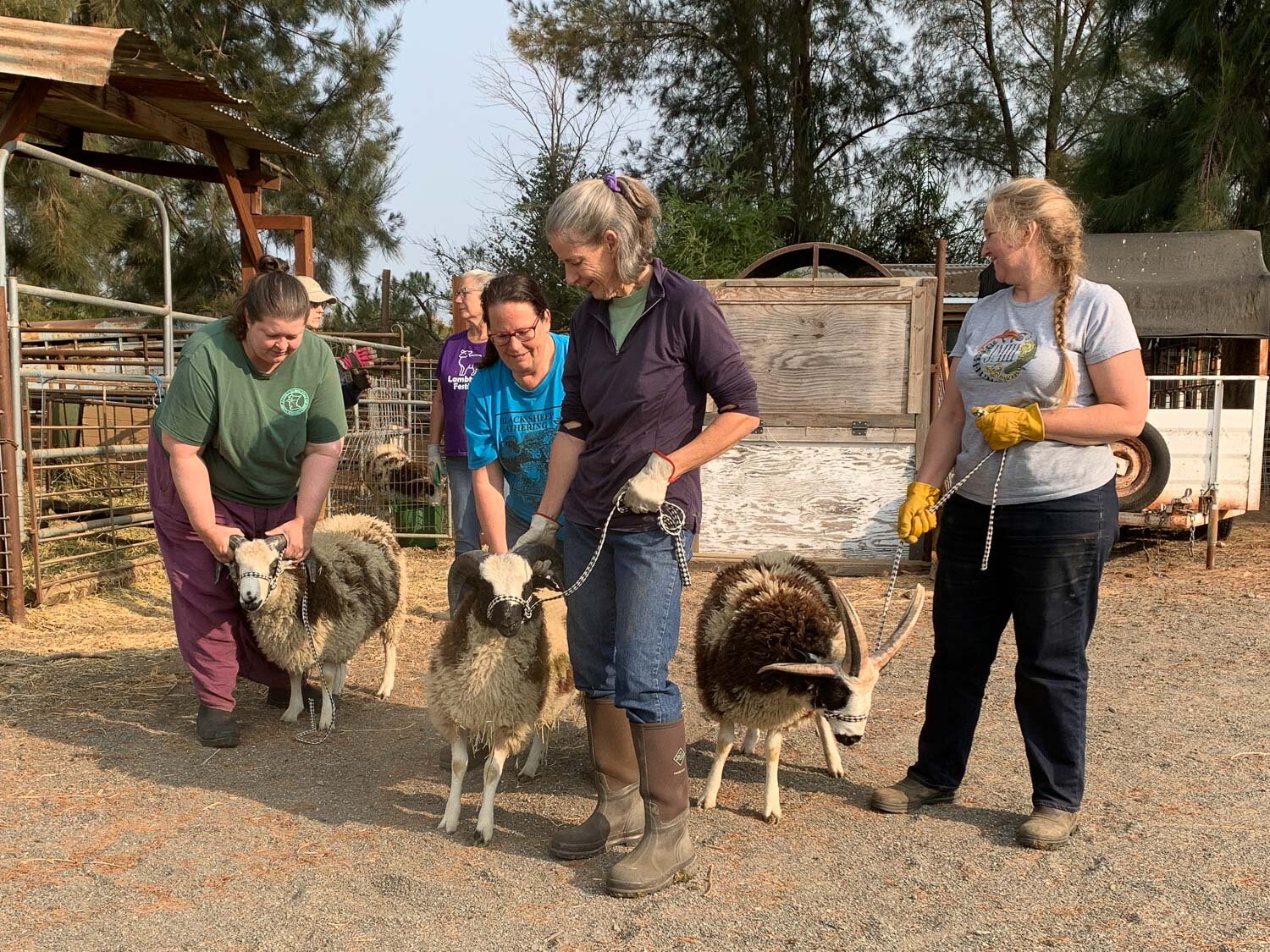
It was time to get the rams. Farm Club members went to get the ram lambs. I had worked with Axis (left) and Silverado (right) a bit…

…but Barrett is the new one and he thought dragging was the way to go rather than walking…

…or maybe giving up was best.

We had planned a break at 10:00 to watch the Lambtown Sheep-to-Shawl judging. We missed the first part so didn’t hear what most of what they said about ours—we can watch the recording when it’s posted.

The judging presentation was good, but unfortunately our shawl was among the four that were disqualified based on size. We were short of the desired 72” by only about 2”. I guess we were in good company. Back to work.

The lamb, Axis, got down to business right away.

The youngest one, Barrett, was interested but the ewes wanted nothing to do with him. In cases you’re wondering, it’s not that he’s too little, it’s just that they aren’t in heat right now.

Dan and I caught the big rams.

Tamarisk’s face has been looking a little rough, but he seems OK other than something under his jaw. (Thanks for the photos Susan.)

I caught him about a week ago to check out his swollen face. He has something going on with his jaw but I think that whatever it is has healed—it’s hard like bone, not soft like an abscess. He still eats and is in good flesh.

If there is something with his jaw it’s not on his mind right now.

I had to chase this group out to the pasture because they got distracted by each other and were just hanging around the lane.
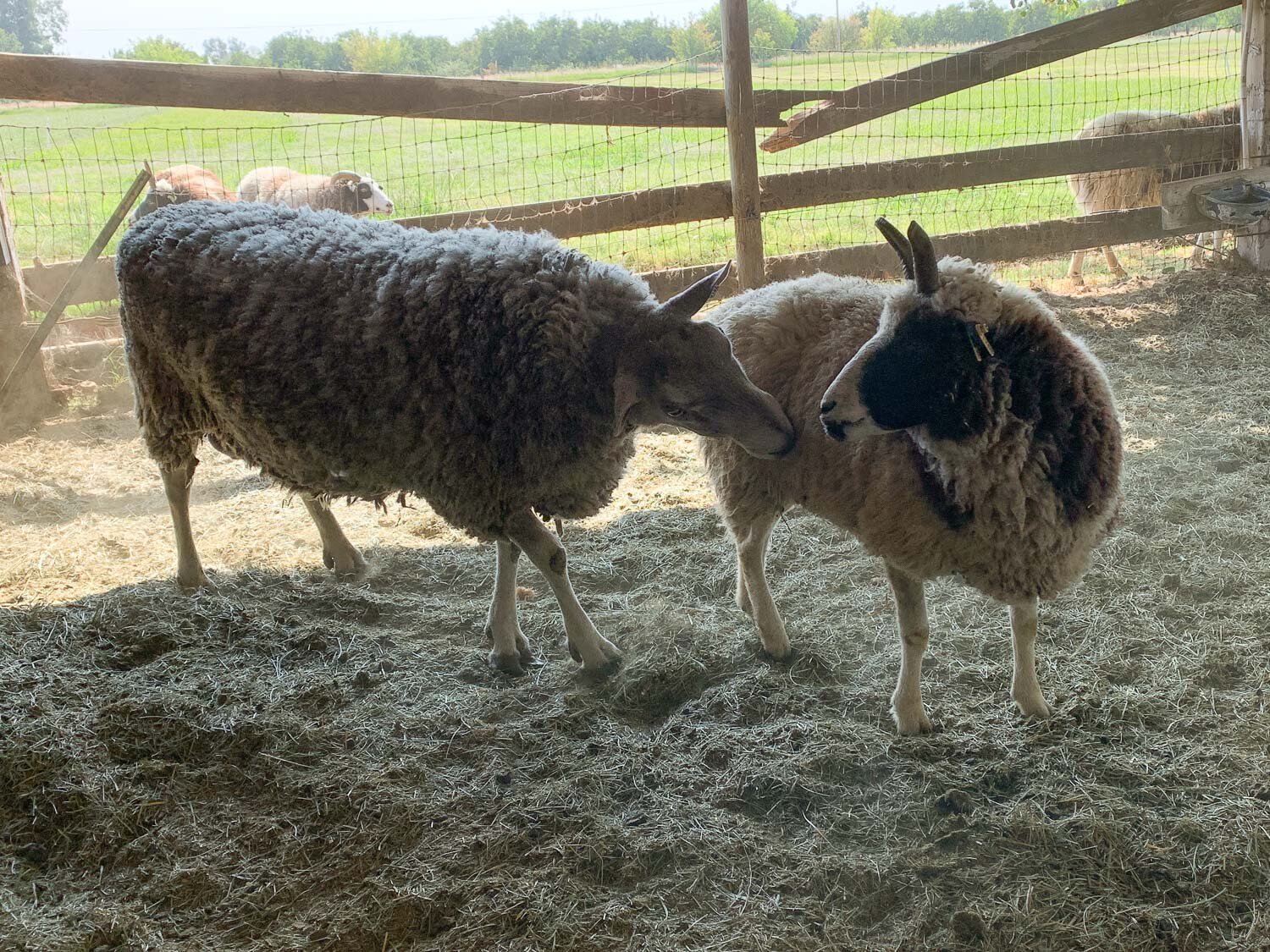
Peyton was happy to have some female company.

Ram lamb, Silverado, seemed more interested in the smells in the ram pen where the older rams had been.

Rambler’s group also has a pasture that is separate from Tamarisk but they can also go into the corral near the barn.

Everybody’s favorite ewe, Jade, was the first to be marked.

Rambler, Tamarisk, and Peyton all wore themselves out on Sunday afternoon. Among them 10 ewes were already marked.


I have two extra ram lambs, Dylan with 4 horns and Orion with 2 horns. They are both for sale as registered breeding rams.

This is the third day the rams have been with the ewes. Tamarisk has bred 10 of his group of 21 so far.

Peyton has bred 4 of his 5 ewes.

Axis is a lilac ram with some of the lilac ewes and ewes that carry lilac in their pedigrees.


He has marked Zora, left, and Foxy, right and 2 other ewes so far.

I’m still waiting for Barrett (in this photo) and Silverado to mark someone. Maybe tonight.
This is the sixth year that I have purchased wool from the nearby Timm Ranch on their shearing day. Here is an example of the yarn that is spun from the wool and there is a little bit of info about the ranch and the flock at that link.
We were so lucky with the weather. The shearing had already been postponed because of potential rain and if there had been the north wind as the day before it would not have been nearly as pleasant.

The sheep are what I call a ranch blend of Rambouillet, Polypay, and Targhee, all fine wool breeds.

There are not individual sheep of those breeds, as the ranch has raised their own replacements for quite awhile.

I’m glad that so many Farm Club members were able to help because there were two shearers working and we needed to keep up with them.

As a fleece was shorn Alan took it from the shearers and put it on a tarp near the skirting tables.
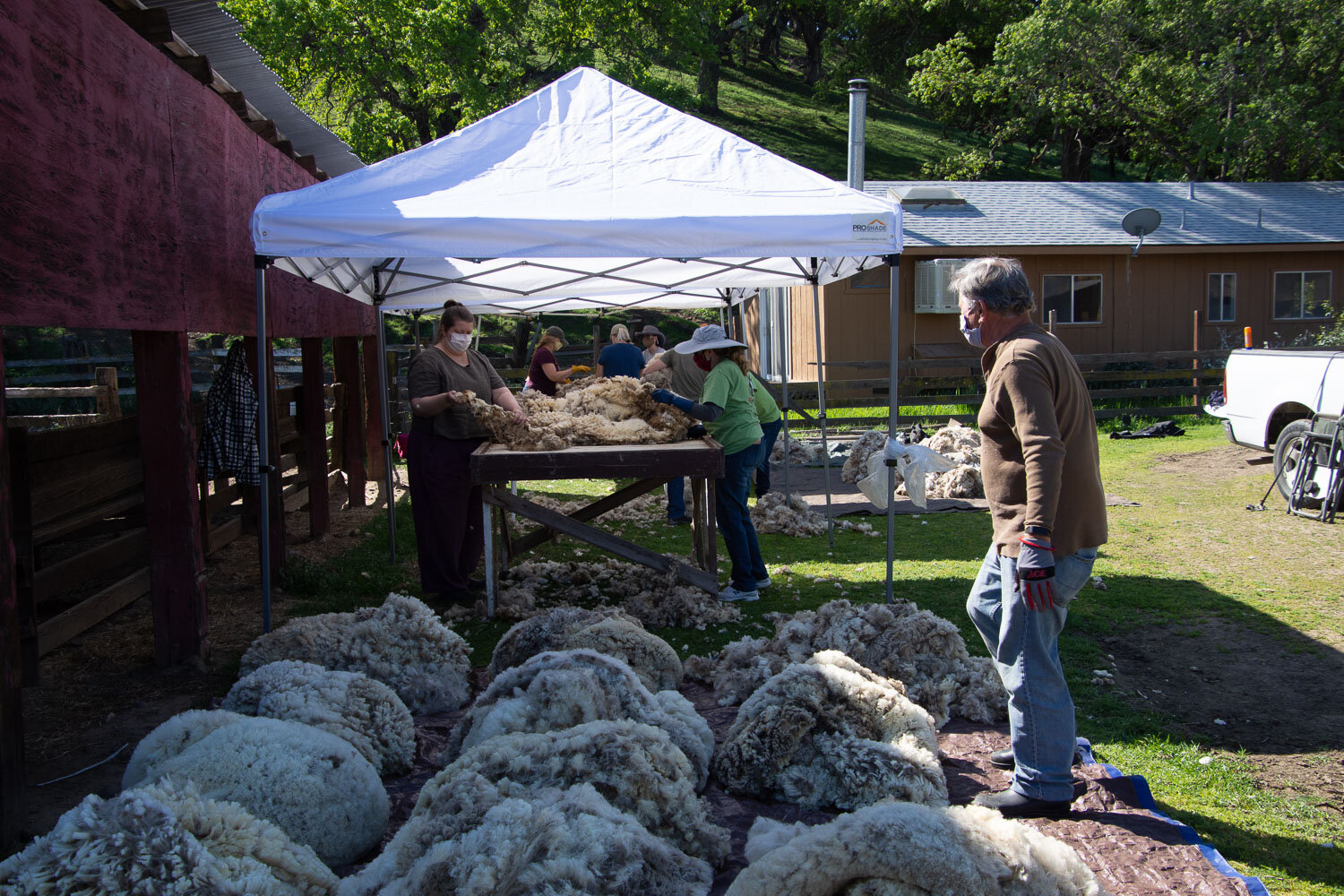

After the first few years of working at the shearing we figured out that we’d better bring canopies or we’d be in the sun the whole day. It was looking very festive here—the canopies cover three skirting tables.

We kept up the safety protocol and everyone wore masks. Some of the Farm Club members had been to this shearing in previous years and it was new for others. Susan, Marina, Kimber are in this photo (I think that I’m able to see who is behind the mask.)

Teresa and Doris are here.

Beth, Carol, and Sylvia.

Thanks for this photo, Doris. I am in this one.
At a commercial shearing operation, the classes and skirters have seconds to spend with each fleece if they hope to keep up with the shearing when 6 or 7 shearers are working. We are a lot slower. The reason is that I feel compelled to send wool that is as free of VM (vegetable matter) and other faults as possible. When we skirt we remove any part of the fleece that isn’t up to a chosen standard. We pull off wool from around the edges where there is going to be more debris or felting, wool with paint markings, wool that has more VM, and wool that may be tender (brittle) or short. The huge mills have processes that deal with VM chemically: Carbonising is a continuous process which combines scouring to remove the wool grease and a chemical process which removes vegetable matter such as seeds, burs and grass. Carbonising occurs if the greasy wool contains a high percentage of vegetable matter (%VM), typically in excess of 2% to 3%. There is more info at this link. My wool is going to a mill that doesn’t do that process so it is important to send only wool that is as clean as possible.
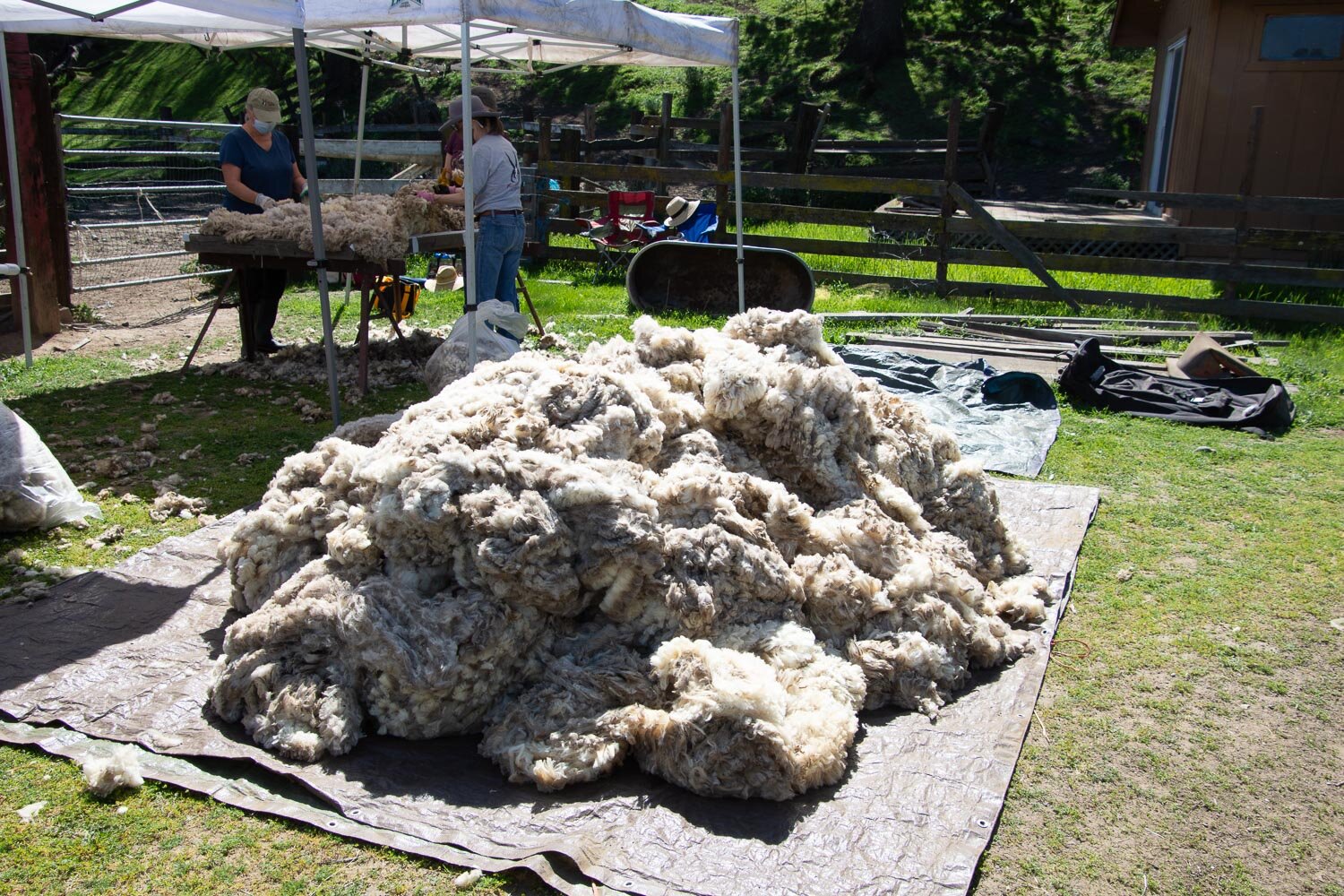
I also needed to keep track of how much wool we had because I needed to meet a minimum of 200 pounds for the mill where I’m sending this wool. So after skirting fleeces we filled bags to be weighed. After recording the weight the wool was piled on a tarp to be baled at the end. The reason that we had to keep up with the shearers is that they brought the wool press with them. They would press our wool and any that we didn’t take into bales before they left. It was important to not have to stuff this pile into bags and boxes, but to get it into a bale for shipment.

Much of the ranch property burned in the devastating LNU Complex fire last summer, but the buildings at this location were spared, probably because the sheep graze the 80 acres that is right around the headquarters.

They were certainly lucky that these old barns didn’t burn.



Our pile got to 230 pounds as the shearers were finishing. They dragged it over to the wool press.


Shearing Day was 5 days ago on 1/29. I can’t believe that I haven’t shared photos yet. I often think in terms of photos and blog posts, but they don’t always make it to the computer. The first post I meant to write was about getting ready for Shearing Day.

Tuesday night the area was hit with a wild storm and huge winds. On Wednesday we drove to a friend’s farm about 5 miles away to bring her sheep to our place so they would be dry for shearing. We now know how many sheep we can put in our trailer—that would be 20 in full fleece. The sheep were soaked but by bringing them here they had a chance to dry out and our shearer added them on after shearing our sheep..
Tuesday night our power went out and stayed out for almost 24 hours and we were luckier than many to be out of only that long, especially since I didn’t think John would want to hand shear 88 sheep.

Wednesday morning I got the barn organized for shearing. I found the plywood we save for shearing next to the stack of straw. It looks as though last year someone labeled it so that it wouldn’t be cut up and used for something else before this year. Good idea.

We started with the rams. This is 2 year old Jasper.

Shearing Day is usually an Open House and we have a lot of visitors and fleece buyers. This pandemic year was an exception, but I was glad that some Farm Club members could come and help. In fact they did most of the work of moving sheep and handing them off to John.

Sheep-eye-view of the holding pen.

The whole day went so smoothly. Everyone had a job and knew what to do. The few brand new Farm Club members jumped right in as well and the “old-timers” showed them what to do and talked about handling sheep.

John sheared 8 rams and wethers and then moved onto the ewes.

Mary scooped the fleeces off the shearing board and her husband, Russ, held the bag open for the fleece.

Kathleen was happy to do her regular job of weighing fleeces.


As usual Ginny entertained herself with the ball. This time she put the ball through the fence where John was shearing, hoping that someone would throw it for her. This time John’s dog, Oakley, picked it up and they both ran off.

Later Oakley found a piece of horn which I think he liked better than the ball.

John sheared all 68 of our sheep and then took a break before shearing the my friend’s 20 sheep.

While John ate lunch we held a raffle that was open to those members who had renewed their membership. We raffled off the shawls that our Meridian Jacobs teams had woven at 2019 Black Sheep Gathering and 2020 Lambtown Sheep-to-Shawl contests. It was fitting that Marina won the shawl woven by the team she was on in 2019. Two other members who couldn’t be at shearing will pick up the Lambtown shawl and another that I wove as a sample before the Lambtown competition.

The ram lamb (almost a year), Rambler and his wether buddy in the background. Remember this look—you’ll never see him this white again.
Stay tuned for more shearing photos tomorrow!
I wrote about my experience at this year’s Lambtown in Dixon, California here.

On Sunday morning while I was getting my vendor booth ready for the day the Sheep to Shawl (S2S) teams were gathering. There were to be seven under this tent and one of them was the Farm Club team! Before Lambtown opened for business I looked for the other Farm Club members who were supporting Lambtown one way or another. We had pretty good representation!

Gynna and Roy (along with Hank this year) were the brains behind Lambtown the last few years and responsible for it’s revival and success.

Jackie helped in the Fibershed Coop booth but was also staffing the booth for Solano County CART (Community Animal Response Team). Stephany spent most of her time helping to organize and then staff the Fibershed booth.

Shoppers are an important part of the event. Dona and Mary exemplify the best kind of shopper.

Lisa volunteered at Lambtown and did her share of shopping as well, finding the naturally colored cotton that I was selling.

As I got back to the Sheep-to-Shawl tent I found five more Farm Club members. Alison and Marina were already committed to the Silverado Spinster’s team, but it was Alison that got the Farm Club team organized back in July.

Here Kathleen has joined them, also on the Silverado team.

The all-important tea for Alison.

I didn’t get a photo of Carol but she is represented on this team.

Farm Club member, Deborah, was also on a different team—Spindles and Flyers.

This is the Meridian Jacobs’ Farm Club team (and me) just before the competition started. There are 4 spinners, 1 plyer, 1 “go-fer”, 1 educator, and the weaver. They can all work on fiber prep but they all have to stick to their other jobs. The loom was warped with handspun Jacob wool of course.

Here are the posters that the team prepared as part of the education component of the contest.

When the call to start was made, the team all began fiber prep.
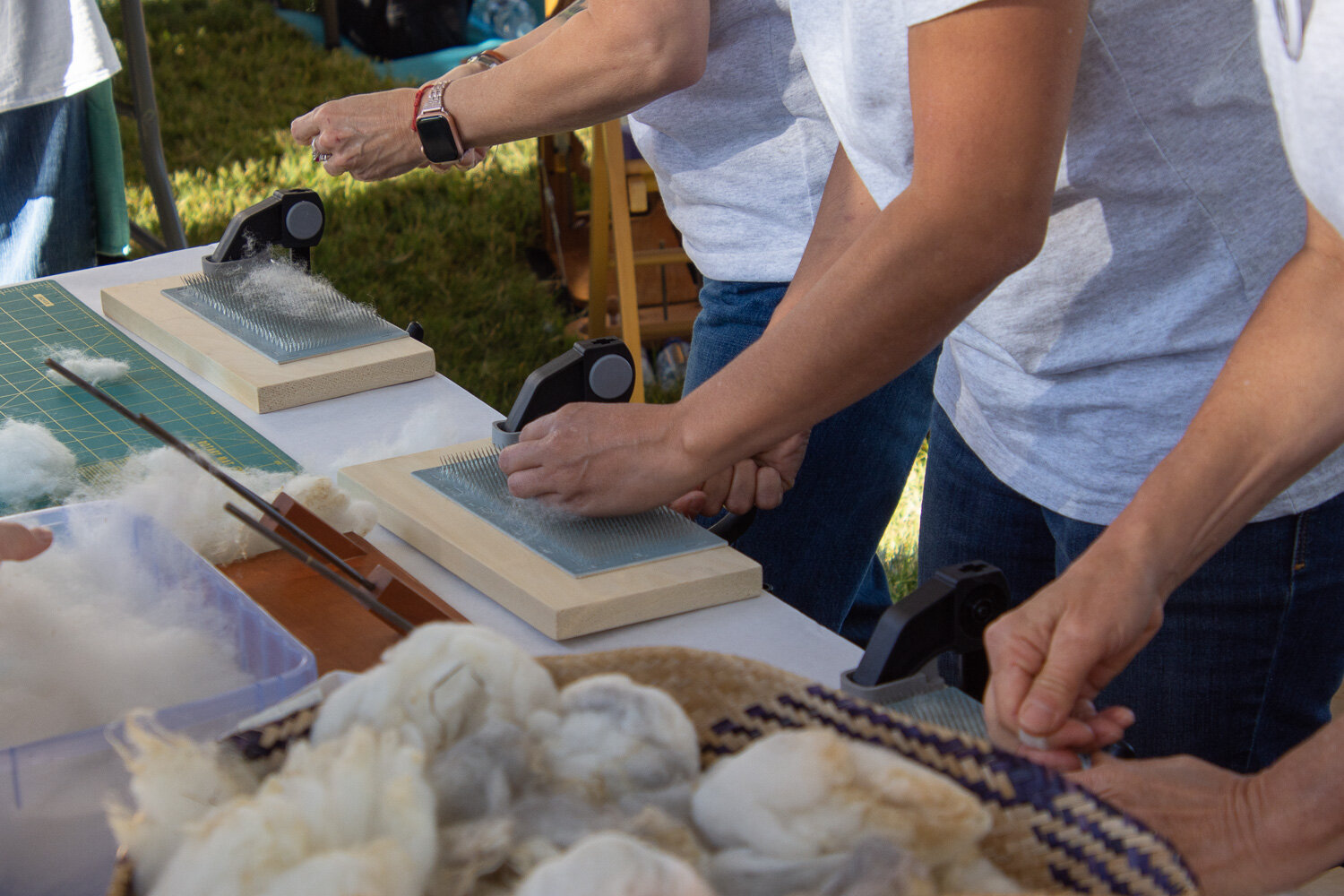
Opening locks before putting them through the drum carder.

Note the bandaid box. Safety first!

Seen on a spinning wheel.
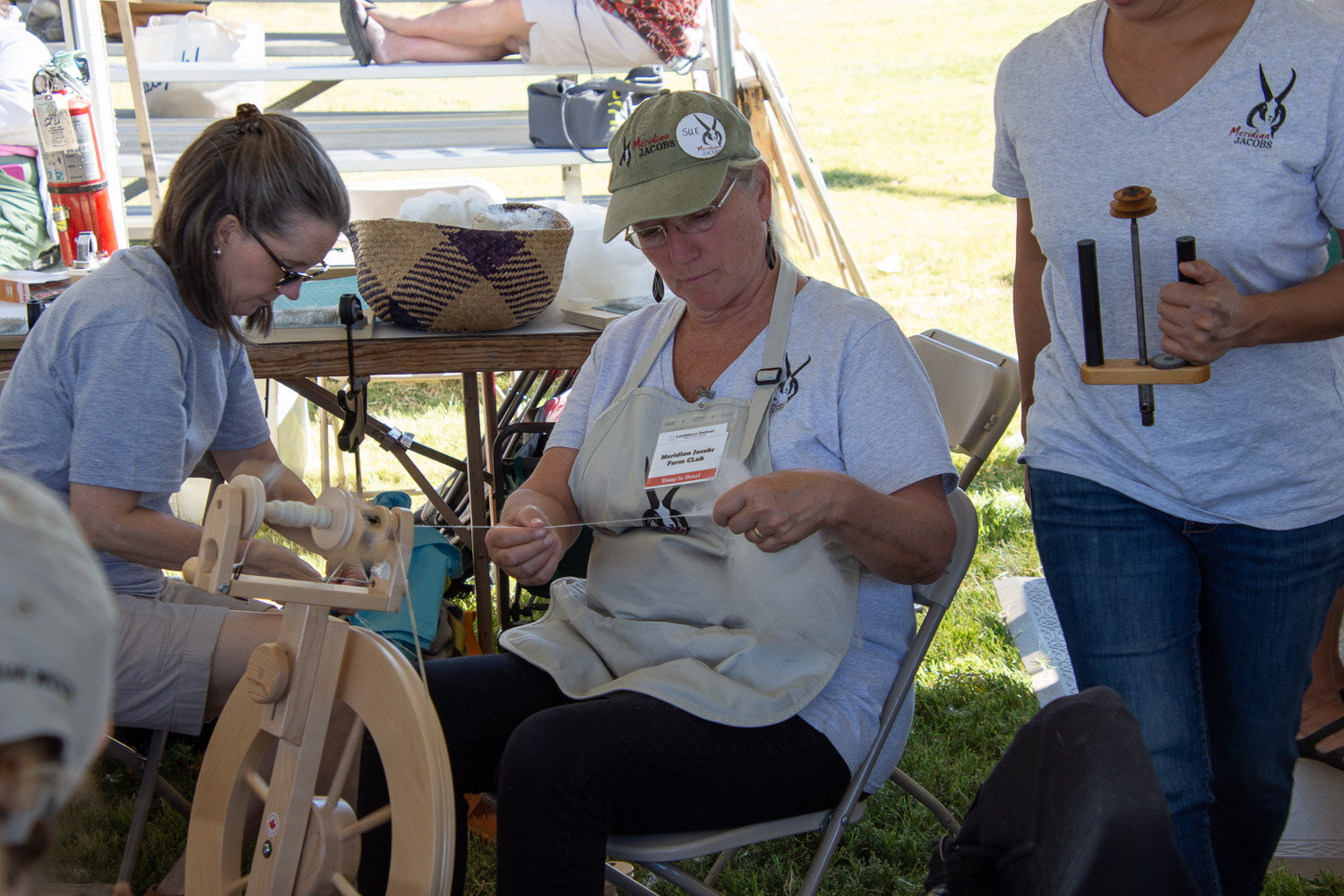
Spinning is underway.

Brenda seemed to be having a good time.

The weaver, Reba, had to focus since she had a rather long treadling sequence to get the pattern she planned.

I love that our team thought up the “secret message” that unrolls as the warp is woven.

Alison, on the neighboring team, used headphones to help her concentration while weaving.

This is the beautiful pattern that Reba wove. The shawl was not finished in the allotted time, and the team agreed that it was better to leave it on the loom and finish it later rather than cut if off just to make a time limit.
I can’t wait to see this when it is really finished! Go Team!
At Meridian Jacobs farm we raise Jacob sheep and sell locally grown wool fiber, yarn, and handwoven goods. We teach fiber classes and sell Ashford, Clemes & Clemes, and Schacht spinning and weaving equipment. We encourage farm visits with field trips and our unique Farm Club.
Search blog posts since 2019. If the search says it can’t find a post try putting in your search word a second time. I don’t know why but the second time it seems to work.
Search the entire website, including older blog posts.